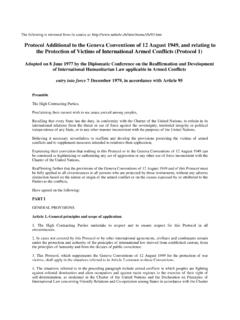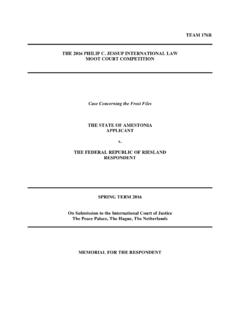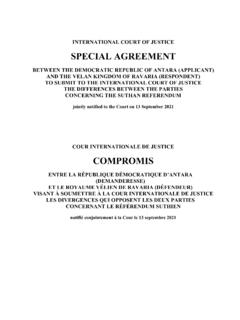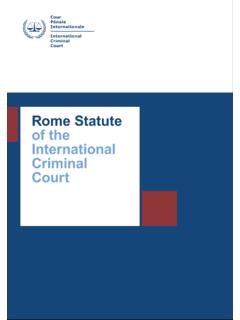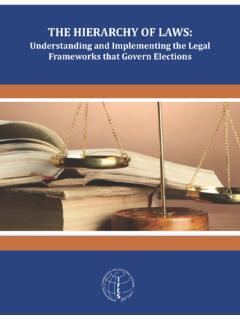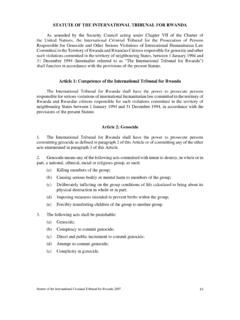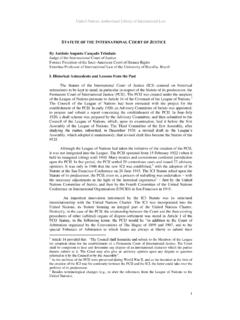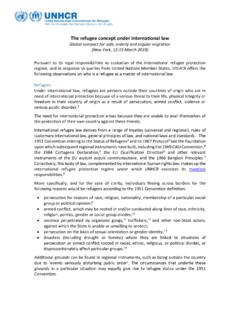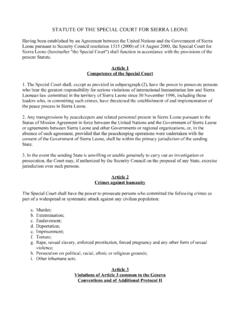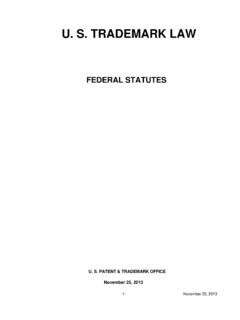Transcription of Introduction to International Law Robert Beckman and ...
1 Introduction to International Law Robert Beckman and Dagmar Butte A. PURPOSE OF THIS DOCUMENT This document is intended to provide students an overview of International law and the structure of the International legal system. In many cases it oversimplifies the law by summarizing key principles in less than one page in order to provide the student with an overview that will enhance further study of the topic. B. DEFINITION OF International LAW International Law consists of the rules and principles of general application dealing with the conduct of States and of International organizations in their International relations with one another and with private individuals, minority groups and transnational companies.
2 C. International LEGAL PERSONALITY International legal personality refers to the entities or legal persons that can have rights and obligations under International law. 1. States A State has the following characteristics: (1) a permanent population; (2) a defined territory; (3) a government; and (4) the capacity to enter into relations with other States. Some writers also argue that a State must be fully independent and be recognized as a State by other States. The International legal system is a horizontal system dominated by States which are, in principle, considered sovereign and equal. International law is predominately made and implemented by States. Only States can have sovereignty over territory.
3 Only States can become members of the United Nations and other International organizations. Only States have access to the International Court of Justice.. 2. International Organizations International Organizations are established by States through International agreements and their powers are limited to those conferred on them in their constituent document. International organizations have a limited degree of International personality, especially vis- -vis member States. They can enter into International agreements and their representatives have certain privileges and immunities. The constituent document may also provide that member States area legally bound to comply with decisions on particular matters.
4 2 The powers of the United Nations are set out in the United Nations Charter of 1945. The main political organ is the General Assembly and its authority on most matters (such as human rights and economic and social issues) is limited to discussing issues and making recommendations. The Security Council has the authority to make decisions that are binding on all member States when it is performing its primary responsibility of maintaining International peace and security. The main UN judicial organ is International Court of Justice (ICJ), which has the power to make binding decisions on questions of International law that have been referred to it by States or give advisory opinions to the 3. Nationality of individuals, companies, etc.
5 Individuals are generally not regarded as legal persons under International law. Their link to State is through the concept of nationality, which may or may not require citizenship. Nationality is the status of being treated as a national of a State for particular purposes. Each State has wide discretion to determine who is a national. The most common methods of acquiring nationality at birth are through one or both parents and/or by the place of birth. Nationality can also be acquired by adoption and naturalization. Companies, ships, aircraft and space craft are usually considered as having the nationality of the State in whose territory they are registered. This is important because in many circumstances States may have International obligations to regulate the conduct of their nationals, especially if they are carrying out act activities outside their territory.
6 Under the principle of nationality of claims, if a national of State A is injured by State B through internationally unlawful conduct, State A may make a claim against State B on behalf of its injured national. This is known as the doctrine of diplomatic protection. D. SOVEREIGNTY OF STATES OVER TERRITORY Sovereignty is the exclusive right to exercise supreme political authority over a defined territory (land, airspace and certain maritime areas such as the territorial sea) and the people within that territory. No other State can have formal political authority within that State. Therefore, sovereignty is closely associated with the concept of political independence. Classical International law developed doctrines by which States could make a valid claim of sovereignty over territory.
7 The doctrines included discovery and occupation and prescription. During the period of Western colonial expansion new territories and islands were subject to claims of sovereignty by discovery and occupation. Sovereignty could also be transferred to another State by conquest (use of force) or by cession where the sovereignty over the territory would be ceded by treaty from one State to another. 3 Since a State has sovereignty over its territory, the entry into its territory by the armed forces of another State without consent is a prima facie breach of International law. Among the attributes of sovereignty is the right to exclude foreigners from entering the territory, which is traditionally referred to as the right to exclude aliens.
8 Since a State has sovereignty within its territorial sea (with some exceptions such as the right of innocent passage), it has the exclusive authority to exercise police power within its territory sea. For example, if foreign ships are attacked by pirates in the territorial sea of a State, the only State that can exercise police power and arrest the pirates in the territorial sea is the coastal State. E. International OBLIGATIONS (SOURCES OF LAW) It is generally accepted that the sources of International law are listed in the Article 38(1) of the Statute of the International Court of Justice, which provides that the Court shall apply: a) International conventions, whether general or particular, establishing rules expressly recognized by the contesting states; b) International custom, as evidence of a general practice accepted as law; c) the general principles of law recognized by civilized nations.
9 D) subject to the provisions of Article 59, judicial decisions and the teachings of the most highly qualified publicists of the various nations, as subsidiary means for the determination of rules of law. 1. Treaties International conventions are generally referred to as treaties. Treaties are written agreements between States that are governed by International law. Treaties are referred to by different names, including agreements, conventions, covenants, protocols and exchanges of notes. If States want to enter into a written agreement that is not intended to be a treaty, they often refer to it as a Memorandum of Understanding and provide that it is not governed by International law.
10 Treaties can be bilateral, multilateral, regional and global. The law of treaties is now set out in the 1969 Vienna Convention on the Law of Treaties which contains the basic principles of treaty law, the procedures for how treaties becoming binding and enter into force, the consequences of a breach of treaty, and principles for interpreting treaties. The basic principle underlying the law of treaties is pacta sunt servanda which means every treaty in force is binding upon the parties to it and must be performed by them in good faith. The other important principle is that treaties are binding only on States parties. They are not binding on third States without their consent. However, it may be possible for some or even most of the 4provisions of a multilateral, regional or global treaty to become binding on all States as rules of customary International law.

